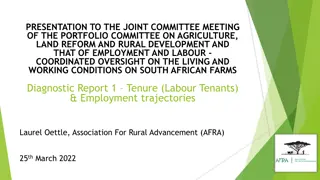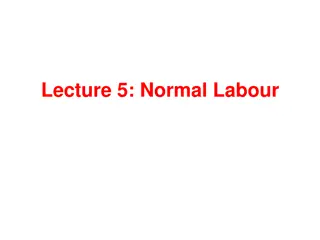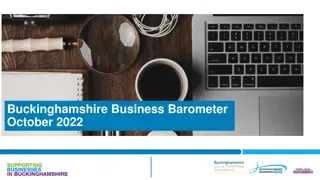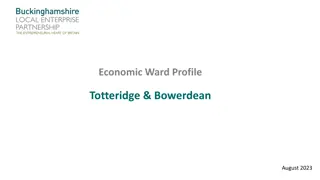Buckinghamshire Labour Market and Skills Analysis 2023
This slide deck provides an insightful analysis of Buckinghamshire's labour market and skills needs for August 2023. It covers various aspects such as the county's largest sectors, sector specialisms, employment trends, demographic profile, levels of economic activity, and skills available for the local economy. The presentation offers valuable information for understanding the current scenario and future prospects in Buckinghamshire.
Download Presentation

Please find below an Image/Link to download the presentation.
The content on the website is provided AS IS for your information and personal use only. It may not be sold, licensed, or shared on other websites without obtaining consent from the author.If you encounter any issues during the download, it is possible that the publisher has removed the file from their server.
You are allowed to download the files provided on this website for personal or commercial use, subject to the condition that they are used lawfully. All files are the property of their respective owners.
The content on the website is provided AS IS for your information and personal use only. It may not be sold, licensed, or shared on other websites without obtaining consent from the author.
E N D
Presentation Transcript
Buckinghamshire Labour Market and Skills Analysis: 2023 August 2023
About About This slide deck has been produced to share analysis of Buckinghamshire s labour market and skills needs in an accessible way. Links to source data are provided wherever possible. If you have any queries, feedback or suggestions for further analysis, please contact Caroline Hargrave caroline.hargrave@buckslep.co.uk
What would you like to know? What would you like to know? At a glance Buckinghamshire s labour market and skills strengths Buckinghamshire s labour market and skills challenges
What would you like to know? What would you like to know? Section 1: About the economy What kind of economy does Buckinghamshire have? What are Buckinghamshire s largest sectors? What are Buckinghamshire s sector specialisms? Which sectors are predicted to create the most jobs in Buckinghamshire over the next 10 years? How many people work in Buckinghamshire s key sectors? Who are Buckinghamshire s biggest employers? How many people commute into and out of the county for work? What is the occupational profile of the Buckinghamshire workforce? What are the occupations of Buckinghamshire residents? What are Buckinghamshire s occupational specialisms? What are the occupations of Buckinghamshire s self-employed workforce?
What would you like to know? What would you like to know? Section 2: About the labour market What levels of economic activity and inactivity are there within Buckinghamshire? How has unemployment in Buckinghamshire changed over time? How many people are claiming unemployment benefit? To what extent has productivity been growing in Buckinghamshire in recent years? To what extent have wages been growing in Buckinghamshire in recent years? What is Buckinghamshire s demographic profile? To what extent is there deprivation within Buckinghamshire?
What would you like to know? What would you like to know? Section 3: Skills available for local economy How qualified is the local labour pool? Who are Buckinghamshire s main providers of education and training? What are Buckinghamshire s apprenticeship take-up levels? How have apprenticeship reforms and the Covid-19 pandemic affected the take-up of apprenticeships in Buckinghamshire? What subjects have been studied by those graduating from Buckinghamshire s Higher Education Institutions? What to those graduating from Buckinghamshire s Higher Education Institutions do next? Where do Buckinghamshire graduates live after graduating? To what extent do Buckinghamshire employers provide training to their staff? How do employers fill vacancies and develop talent pipelines?
What would you like to know? What would you like to know? Section 4: Skills demand within the local economy How can demand for skills be measured? What types of jobs are in greatest demand in Buckinghamshire? Which sectors are predicted to create the most jobs in Buckinghamshire over the next 10 years? What skills need developing in Buckinghamshire? What is the demand for digital skills within Buckinghamshire? In which sectors and occupations should we prioritise skills activities to meet current and future demand within Buckinghamshire? What training do Buckinghamshire employers find most valuable?
What would you like to know? What would you like to know? Section 5: The extent of skills mismatches within Buckinghamshire To what extent do Buckinghamshire employers struggle to fill vacancies, and why? What job roles are particularly difficult to fill? And how does Buckinghamshire compare with the national average? To what extent are there skills mismatches within the existing workforce?
At a glance At a glance
Buckinghamshires labour market and skills strengths Strengths High employment rates. High wages (particularly for residents but also Buckinghamshire workers). High levels of qualifications amongst residents. Higher than average Level 2 and 3 attainment by young people. High proportion of young people entering sustained positive destinations after both Key Stage 4 and Key Stage 5. Further and Higher Education Institutions with a strong history of employer engagement, and a focus on applied learning and employability. World-class talent in industries such as high-performance engineering, film & TV, space and medtech Significant job growth expected in a variety of sectors over the next few years, in particular in the film & TV and construction sectors. A strong collaborative culture (between education institutions, and between employers and educators). High levels of employer involvement in the local skills agenda. Clear long-term economic growth aspirations set out in the Buckinghamshire Local Industrial Strategy. A top performing Careers Hub. A top performing business Growth Hub
Buckinghamshires labour market and skills challenges Challenges (1 of 2) High levels of out-commuting of highly skilled residents Buckinghamshire s unemployment and claimant count rates are closer to the national average than they have been historically (historically they have been much lower). An increasing proportion of economically inactive working-age residents are inactive due to ill health. Ensuring strong local talent pipelines for growing sectors (including life sciences, health and social care; film & TV; construction; high performance engineering; space). Ensuring a strong talent pipeline of green skills (including digital and engineering skills) to enable the shift towards a net zero economy. Retaining and attracting talent (school leavers, graduates and high skilled residents) linked to the perceived attractiveness of the County s main towns and the rural nature of much of the County. Low take-up of apprenticeships, and fewer apprenticeships at level 2. Higher than average rates of 16-17 year olds classified as being NEET or activity not known. A lack of engineering training provision within the county. Low levels of interest in construction and health and social care careers, resulting in employers. struggling to fill vacancies. Pockets of inequality and poor social mobility.
Buckinghamshires labour market and skills challenges Challenges (2 of 2) Recruitment difficulties causing problems for employers in many sectors and hampering business growth. In some cases this is linked to wider issues such as a lack of affordable housing and poor transport links. Relatively low take-up of apprenticeships, and fewer apprenticeships at level 2. Employer demand for new entrants to be better work ready. Lower than average levels of training by County employers. Ever-growing and evolving demand for digital skills, including utilising AI. Ensuring opportunities in growth sectors are accessible to all. Mismatch between the demand for skills and labour within the local economy, and the skills held and jobs sought by local residents.
Section 1: About the economy Section 1: About the economy
Back to index What kind of economy does Buckinghamshire have? As with most of the developed world, Buckinghamshire s economy is dominated by the service sector, which provides 85% of all local employee jobs1. 50% A higher proportion of those working in the Buckinghamshire economy work for small firms (employing fewer than 50 people) than the national average2. 41% 45% 40% 33% Defining features of Buckinghamshire s economy include: 35% 30% The dominance of small businesses2. 25% High levels of self-employment, particularly within the county s creative and construction sectors. 20% 15% 10% World-class economic assets and high performing clusters of business activity in the areas of film and TV, high- performance engineering, space and MedTech. 5% 0% Buckinghamshire England A comparatively large wholesale sector (particularly the wholesale of pharmaceutical goods, machinery and equipment, computers and software)1. Approximately 1 in every 6 people working in the Buckinghamshire economy are self-employed3 Larger than average construction, business admin and support, info and comms and mining, quarrying & utilities sectors1. 1 Business Register and Employment Survey, 2021, ONS 2 Inter Departmental Business Register, 2022. ONS 3Annual Population Survey workplace analysis (Jan Dec 2022), ONS
Back to index What kind of economy does Buckinghamshire have? There were 31,355 VAT/PAYE registered businesses (enterprises) operating in Buckinghamshire in March 2022, a decrease of 0.4% from March 2021. These businesses operated from 34,520 individual units (or workplaces). A decrease of 0.5% from March 20211. Business survival rates in Buckinghamshire are higher than the national average. 100 Buckinghamshire % firms born in 2016 surviving for 90 England 80 70 60 43.6 In 2021 (latest available data), Buckinghamshire had a relatively stable business population. Fewer businesses were created, and fewer businesses closed (as a proportion of all existing business) than the national average. 38.0 50 40 30 14% 20 Buckinghamshire 10 England 12% 0 10% 1-year 2-year 3-year 4-year 5-year 8% In 2021, there were slightly more high growth businesses in Buckinghamshire than the national average (4.2% of all businesses employing more than 10 people, compared with 3.8%)2. 6% 4% 2% 0% 1 UK Business Count, 2022, ONS Birth rate Death rate 2 Business demography, UK - Office for National Statistics (ons.gov.uk)
Back to index What are Buckinghamshire s largest employment sectors? The health and social care and the business admin and support services sectors are the largest in Buckinghamshire in terms of the number of people they employ. 0% 2% 4% 6% 8% 10% 12% 14% Health Business admin & support services Professional, scientific & technical Retail Education Manufacturing Wholesale Construction Hospitality Info & comms The wholesale; construction and business admin and support services sectorsemploy comparatively more people in Buckinghamshire than the national average. Arts, ent, recreation & other services Transport & storage Public admin & defence Motor trades Financial & insurance Property Mining, quarrying & utilities Agriculture etc Source: Business Register and Employment Survey, 2021, ONS Buckinghamshire England Sector definitions can be found here
Back to index What are Buckinghamshire s largest employment sectors? The prevalence of part-time working varies considerably by sector 0 5,000 10,000 15,000 20,000 25,000 30,000 Health Business admin & support services Professional, scientific & technical Buckinghamshire s retail and health and social care sectors employ the largest number of people on a part-time basis. Retail Education Manufacturing Wholesale Construction Hospitality Info & comms Buckinghamshire s business admin & support and professional, scientific and technical and health sectors employ the largest number of people on a full-time basis. Arts, ent, recreation & other services Transport & storage Public admin & defence Motor trades Financial & insurance Property Mining, quarrying & utilities Agriculture etc Full-time Part-time Source: Business Register and Employment Survey, 2021, ONS Sector definitions can be found here
Back to index What are Buckinghamshire s sector specialisms? Buckinghamshire has nearly twice much employment in the wholesale sector than the national average. The chart to the right shows how the structure of Buckinghamshire s economy differs to the national economy, based on the number of employees in different sectors. Agriculture etcMining, quarrying & Arts, ent, recreation & other services 2.0 utilities Manufacturing 1.8 Health 1.6 1.2 1.4 1.2 The orange ring is the national average, and the turquoise ring is employment within the Buckinghamshire economy. Where the turquoise ring sits outside the orange ring, Buckinghamshire has a higher proportion of people employed than the national average. Education Construction 1.0 1.4 0.8 0.6 Public admin & defence 0.4 Motor trades 0.2 0.0 1.8 Wholesale Business admin & support services 1.2 Professional, scientific & technical The numbers on the chart are location quotients. A location quotient over 1 shows a local specialism. The five broad sectors* of the economy in which Buckinghamshire has a specialism are: wholesale (1.8 times more employment in this sector locally than nationally), construction (1.4 times more), info and comms (1.2 times more), business admin (1.2 times more) and mining, quarrying & utilities (1.2 times more). Retail 1.2 Property Transport & storage Financial & insurance Hospitality Info & comms Buckinghamshire England Source: Business Register and Employment Survey, 2021, ONS *this analysis uses broad Standard Industrial Classification codes. The analysis on the following pages provides more granular insight
Back to index What are Buckinghamshire s sector specialisms? There are twice as many creative industry jobs within the Buckinghamshire economy than the national average, many of which are in the film and TV sector. Buckinghamshire also has higher than average levels of employment in advertising, specialist design, artistic creation and sound recording / music publication1. Some sectors or clusters of business activity are not well defined within the Standard Industrial Classification (SIC) code system or are not captured well when using the broad classification codes (see previous pages). There are approximately 70 companies involved with the wholesale of pharmaceuticals goods in Buckinghamshire. They employ nearly 9 times as many people in county than the national average1. However, using 4 and 5 digit SIC codes, along with our knowledge of the local economy, we can dig deeper to gain a more granular understanding of Buckinghamshire s sector specialisms and the demand for labour and skills within them There are approximately 60 companies involved with waste collection in Buckinghamshire. They employ nearly 5 times as many people in county than the national average1. 1 Business Register and Employment Survey, 2021, ONS
Which sectors are predicted to create the most jobs in Buckinghamshire over the next 10 years? The Space, Creative Industries, High Performance Engineering and MedTech sectors are identified within Buckinghamshire s Local Industrial Strategy as key sectors. Each has a significant asset located within the County (Westcott Space Cluster, Pinewood Studios, Silverstone Park and Technology Cluster and Stoke Mandeville hospital) and strong long-term growth prospects. Key growth sectors (from an employment perspective) within Buckinghamshire over the next 10 years will be: Construction (in part due to HS2, East West Rail, Aylesbury Garden Town related construction activity, and a large house building programme) Film and TV (linked to expansion plans at Pinewood Studios, plus the continuing inward investment boom of the West of London Screen Cluster, with many new studios opening within the next few years) Life sciences, health and social care (linked to both the health needs of an ageing population and the need to respond to the aftermath of the Covid-19 pandemic) Space (linked to expansion of the Westcott Space Cluster) High performance engineering (linked to expansion of the Silverstone Enterprise Zone and an increasing focus on the need for green technologies to combat climate change) Pinewood Studios expansion plans are predicted to create 8,000 new jobs, including 3,000 construction jobs. There are also plans for a new studio at Marlow. The construction, film/TV and health & social care sectors are expected to create the greatest volume of jobs in Buckinghamshire over the next five years. The construction of HS2 is expected to create around 4,000 jobs over the lifetime of the project in Buckinghamshire and the surrounding areas. It is anticipated that the 10- year plan for the Westcott Space Cluster will create over 2,000 jobs.
How many people work in Buckinghamshires key sectors? In total, approximately 40% of all those working in the Buckinghamshire economy work in the county s key sectors1. These sectors vary considerably in size, with health and social care currently the largest and space the smallest. 1Business Register and Employment Survey, 2021, ONS Note 1 - whilst the digital technology sector is not expected to grow significantly in Buckinghamshire over the next decade, it does employ more people locally than nationally, and is a growing sector globally. Note 2 It is difficult to measure how many people are employed in the space sector in Buckinghamshire. An estimate will be provided in due course.
Who are Buckinghamshires biggest employers? Some of Buckinghamshire s largest employers can be found in the graphic to the right In addition to the above, national companies who employ large numbers of people within the local economy include national construction companies, national retail chains, national hospitality chains, national care home chains and global film production companies.
How many people commute into and out of the county for work? Buckinghamshire has one of least self-contained labour markets in England. In 2011 (latest available data), around a third of working residents travelled out of the county for work whilst 28% of all those working within the Buckinghamshire economy travel into the county from elsewhere. In total, 34,000 Buckinghamshire residents usually work in London. There are some sector specific commuting patterns. Within the film and TV sector for example (which is concentrated in the south of the county), film crews of up to 1,000 per large production, primarily freelancers, move between studios. Source: Census 2011, ONS Commuting patterns matter when undertaking local labour market and skills analysis, particularly when trying to compare data on the demand for, and supply of, skills. For example, whilst Buckinghamshire may have a large number of highly qualified residents, high levels of out-commuting, often for high paid jobs, means that the skills of many of these residents are not available to Buckinghamshire employers, nor are these individuals directly contributing to the output and productivity of the local economy.
What is the occupational profile of the Buckinghamshire workforce? This chart shows how the broad occupational profile of Buckinghamshire s workforce compares with the occupational profile of England as a whole. 0% 5% 10% 15% 20% 25% 30% Managers and Senior Officials The largest occupational group in Buckinghamshire is professional . A similar proportion of the local workforce work in professional roles than nationally. Professional Associate Prof & Tech Administrative and Secretarial The second largest occupational group in Buckinghamshire is associate professional & technical . A large proportion of the workforce work in this occupational group locally than nationally (18% versus 15%). Skilled Trades Personal Service Sales and Customer Service Process, Plant and Machine More people work in managerial roles in the Buckinghamshire economy than nationally. Fewer people work in sales and customers service and in process, plant and machine operatives and elementary roles. Elementary Buckinghamshire England Source: Annual Population Survey (workplace analysis) Jan to Dec 2022
What are the occupations of Buckinghamshire residents? 0% 5% 10% 15% 20% 25% 30% Managers and Senior Officials This chart shows how the occupational profile of Buckinghamshire residents differs to the occupational profile of Buckinghamshire-based workers. Professional Associate Prof & Tech Administrative and Secretarial The two are more similar than they have been in previous years. The biggest difference is at the top end. 16% of Buckinghamshire residents work as managers, directors and senior officials , compared to 14% within the local economy. Skilled Trades Personal Service Sales and Customer Service Process, Plant and Machine Elementary Bucks residents Bucks workers Source: Annual Population Survey (workplace and resident analysis) Jan to Dec 2022
What are Buckinghamshires occupational specialisms? (workplace analysis) This table lists Buckinghamshire s top occupational specialisms (number of employee jobs as a proportion of all employees, compared with employee jobs nationally). 2021 2021 Jobs Description Employment Concentration Animal Care and Control Services Artistic, Literary and Media Occupations Agricultural and Related Trades Elementary Cleaning Occupations Cleaning and Housekeeping Managers and Supervisors Hairdressers and Related Services Sales, Marketing and Related Associate Professionals Functional Managers and Directors Elementary Construction Occupations Information Technology and Telecommunications Professionals Sports and Fitness Occupations Construction and Building Trades Elementary Sales Occupations Production Managers and Directors Managers and Directors in Retail and Wholesale Electrical and Electronic Trades 1.5 1.4 1.4 1.4 1.3 1.3 1.3 1.2 1.2 1.2 1.2 1.2 1.2 1.2 1.1 1.1 1,200 1,900 1,600 8,600 1,000 1,600 11,000 9,800 1,200 9,000 1,300 3,500 1,100 3,900 3,100 3,500 The top occupation is animal care and control services , in which 1.5 as many people are employed locally than the national average, followed by artistic, literary and media occupations , agricultural and related trades and elementary cleaning occupations . Employment Concentrations (EC) are a way of quantifying how concentrated a particular sector or occupation is in a local area as compared to the nation. An EC greater than 1 indicates a specialism. An EC of 2 would show that twice as many people are employed in a certain sector or occupation locally than nationally. Source: EMSI Analyst
What are Buckinghamshires residents occupational specialisms? This table lists the top occupational specialisms of Buckinghamshire s residents (number of residents in an occupation as a proportion of all working residents compared with the proportion nationally). 2021 2021 Jobs Description Employment Concentration 111 Chief Executives and Senior Officials 113 Functional Managers and Directors 125 Managers and Proprietors in Other Services 355 Sales, Marketing and Related Associate Professionals 343 Sports and Fitness Occupations 213 Information Technology Professionals 612 Animal Care and Control Services 112 Production Managers and Directors 243 Business, Research and Administrative Professionals 244 Business and Financial Project Management Professionals 249 Media Professionals 414 Administrative Occupations: Office Managers and Supervisors 341 Artistic, Literary and Media Occupations 242 Finance Professionals 2,700 17,300 8,700 10,500 1,900 9,200 1,100 7,800 4,400 2,600 1,900 2,800 4,100 4,600 2.1 1.8 1.5 1.4 1.4 1.3 1.3 1.3 1.3 1.3 1.3 1.2 1.2 1.2 The top occupation is chief executives and senior officials , in which 2.1 as many people are employed locally than the national average, followed by functional managers and directors , managers and proprietors in other services and sales, marketing and related associate professionals. Employment Concentrations (EC) are a way of quantifying how concentrated a particular sector or occupation is in a local area as compared to the nation. An EC greater than 1 indicates a specialism. An EC of 2 would show that twice as many people are employed in a certain sector or occupation locally than nationally. Note only occupations with more than 1,000 residents are included Source: 2021 Census
What are the main occupations of Buckinghamshires self- employed workforce? Self- employed Occupation Taxi and Cab Drivers and Chauffeurs 2,700 Cleaners and Domestics 1,700 Carpenters and Joiners 1,600 The table to the right provides estimates of the number of people working in different occupations on a self-employed basis within Buckinghamshire. Many of these occupations sit within the construction sectors. The majority of those who are self-employed do not have any employees. Hairdressers and Barbers 1,500 Gardeners and Landscape Gardeners 1,500 Painters and Decorators 1,400 Shopkeepers and Proprietors Wholesale and Retail 1,200 Beauticians and Related Occupations 1,200 Animal Care Services Occupations 1,100 Electricians and Electrical Fitters 1,100 Construction and Building Trades 1,100 Plumbers and Heating and Ventilating Engineers 900 Authors, Writers and Translators 900 Elementary Construction Occupations 800 Actors, Entertainers and Presenters 800 Bricklayers and Masons 700 Photographers, Audio-visual and Broadcasting Equipment Operators 700 Childminders and Related Occupations 600 Van Drivers 600 Estimates based on national data (APS 2021) along with local data from EMSI Analyst
Economic activity of Buckinghamshire residents 2022 Working age population (329,600) Economically inactive (51,700 16%) Economically active (277,900 84%) Unemployed (8,800 3%) Want a job (13,100 4%) Don t want a job (38,600 12%) Employed (269,100 82%) Reason economically inactive Self-employed (38,700 12%) Employees (229,600 70%) Other, 13% Student, 21% Retired, 18% Source: Annual Population Survey, 12 months to December 2022, ONS Looking after family/home, 22% In April 2023, 8,700 people were claiming unemployment related benefits (85% were estimated to be unemployed and 15% working some hours / having low earnings) (Source: DWP, StatXplore)ants Long-term sick, 23% Note 1: students aged 16+ who are in full-time education (school / college / university) will be classified as economically active if they also have a job (e.g. part- time bar work) or are actively seeking work. They will be classified as economically inactive if they are not working and are not actively seeking work. Note 2: Numbers may not add to totals due to rounding. Temp sick, 3%
What is the current state of the labour market and how has this changed over time? Overall, Buckinghamshire s employment and unemployment rates are better than they were 10 years ago. It 2022, Buckinghamshire was estimated to have the highest employment rate of all 38 Local Enterprise Partnership (LEP) areas. However, recent unemployment rates have been similar to the national average. Historically in Buckinghamshire they have been lower. Also, the numbers of people claiming unemployment-related benefits have not yet returned to pre-pandemic levels (see slide 33 onwards). This is in line with the national trend. Buckinghamshire currently (2022) has the lowest economic inactivity rate of all Local Enterprise Partnership areas. People can be classified as being economically inactive (i.e. not working and not currently seeking work) for a wide range of reasons (see slide 32). Employment rate 2012 to 2022 Unemployment rate 2012 to 2022 Economic inactivity rate 2012 to 2022 25.0 90.0 9.0 80.0 8.0 70.0 20.0 7.0 60.0 6.0 50.0 15.0 5.0 40.0 4.0 30.0 3.0 10.0 20.0 2.0 10.0 1.0 5.0 0.0 0.0 Oct 2011-Sep 2012 Oct 2012-Sep 2013 Oct 2013-Sep 2014 Oct 2014-Sep 2015 Oct 2015-Sep 2016 Oct 2016-Sep 2017 Oct 2017-Sep 2018 Oct 2018-Sep 2019 Oct 2019-Sep 2020 Oct 2020-Sep 2021 Oct 2021-Sep 2022 Apr 2012-Mar 2013 Apr 2013-Mar 2014 Apr 2014-Mar 2015 Apr 2015-Mar 2016 Apr 2016-Mar 2017 Apr 2017-Mar 2018 Apr 2018-Mar 2019 Apr 2019-Mar 2020 Apr 2020-Mar 2021 Apr 2021-Mar 2022 Oct 2011-Sep 2012 Oct 2012-Sep 2013 Oct 2013-Sep 2014 Oct 2014-Sep 2015 Oct 2015-Sep 2016 Oct 2016-Sep 2017 Oct 2017-Sep 2018 Oct 2018-Sep 2019 Oct 2019-Sep 2020 Oct 2020-Sep 2021 Oct 2021-Sep 2022 Apr 2012-Mar 2013 Apr 2013-Mar 2014 Apr 2014-Mar 2015 Apr 2015-Mar 2016 Apr 2016-Mar 2017 Apr 2017-Mar 2018 Apr 2018-Mar 2019 Apr 2019-Mar 2020 Apr 2020-Mar 2021 Apr 2021-Mar 2022 0.0 Jul 2012-Jun 2013 Jul 2013-Jun 2014 Jul 2014-Jun 2015 Jul 2015-Jun 2016 Jul 2016-Jun 2017 Jul 2017-Jun 2018 Jul 2018-Jun 2019 Jul 2019-Jun 2020 Jul 2020-Jun 2021 Jul 2021-Jun 2022 Jan 2012-Dec 2012 Jan 2013-Dec 2013 Jan 2014-Dec 2014 Jan 2015-Dec 2015 Jan 2016-Dec 2016 Jan 2017-Dec 2017 Jan 2018-Dec 2018 Jan 2019-Dec 2019 Jan 2020-Dec 2020 Jan 2021-Dec 2021 Jan 2022-Dec 2022 Buckinghamshire England Buckinghamshire England Buckinghamshire England Source: Annual Population Survey, ONS Please note: The Buckinghamshire sample size of the Annual Population Survey is relatively small, and therefore the percentages should be treated with a degree of caution as they are subject to error.
Spotlight on economic inactivity Proportion of working age-population who are economically inactive, by reason for inactivity (note, the Buckinghamshire sample size of the Annual Population Survey is relatively small, and therefore the percentages in the chart below should be treated with a degree of caution) The proportion of working-age residents who are economically inactive* due to ill health appears to have doubled over the last five years. This is in line with the national picture and is broadly considered to be a result of fall-out from the Covid-19 pandemic (e.g. long-Covid or delays in receiving treatment) and longer NHS waiting times. 7.0% % of working-age population who are econoically 6.0% 5.0% inactive - by reason 4.0% The proportion who are inactive due to being full- time students appears to have dropped considerably between 2021 and 2022. It is unclear whether there has been a decline in the number of full-time students living in Buckinghamshire, or whether more students are working and therefore classified as employed rather than inactive. 3.0% 2.0% 1.0% 0.0% 2018 2019 2020 2021 2022 Economically inactive - student Economically inactive - looking after family/home The proportion of working-age residents stating they are retired increased during the height of the pandemic (2020 and 2021) and in 2022 fell back down to 2019 levels. Possibly due to the increased cost of living. Economically inactive - sick Economically inactive - retired Economically inactive - other *not working and not actively seeking work Source: Annual Population Survey, 12 months to December 2022, ONS
How has unemployment in Buckinghamshire changed over time? 9.0 Buckinghamshire s unemployment rate over the last decade and a half has been lower than the national average. Overall, it has tracked national trends but at a lower level, rising following the Great Recession and falling to its lowest rate in recent years in 2018. 8.0 7.0 6.0 5.0 4.0 3.0 2.0 1.0 0.0 Buckinghamshire England Source: Annual Population Survey (resident analysis)
How many people in Buckinghamshire are claiming unemployment related benefits? 7.0 18,000 The number of Buckinghamshire residents claiming unemployment related benefits shot up following the onset of the Covid-19 pandemic and has been gradually falling since March 2021. 16,000 6.0 14,000 5.0 12,000 Buckinghamshire s claimant count rate (claimants as a proportion of all residents aged 16-64) in June 2023 stood at 2.6%, lower than the national average of 3.8%. There has been little change in the number and percentage of claimants over the last 12 months. 4.0 10,000 8,000 3.0 6,000 2.0 4,000 1.0 2,000 Further analysis is presented on the following pages. Head to the Buckinghamshire Economic Intelligence Observatory for the latest data. 0.0 0 Source: Claimant Count, 2023 Bucks - number Bucks % England %
How does Buckinghamshires Claimant Count rate compare to other areas? 7.0 In June 2023, Buckinghamshire had the 10th lowest Claimant Count rate of the 38 LEP areas. At the start of the pandemic, Buckinghamshire had the 4th lowest Claimant Count. 6.0 5.0 4.0 3.0 2.0 1.0 0.0 Source: Claimant Count, 2023
Which areas have seen the biggest increases in Claimant Count rates since the onset of the pandemic? 2.0 1.5 1.0 Buckinghamshire s Claimant Count rate was 0.9 percentage points higher in June 2023 than in March 2020. This places Buckinghamshire 7th of 38 LEP areas in terms of the impact of Covid-19 on Claimant Count rates. London experienced the greatest increase. 0.5 0.0 -0.5 -1.0 Greater Cambridge and Greater Derby, Derbyshire, Nottingham and London Hull and East Yorkshire Swindon and Wiltshire New Anglia Hertfordshire Oxfordshire Greater Manchester South Yorkshire West of England Cornwall and Isles of Scilly North East Greater Birmingham and Solihull Enterprise M3 Coventry and Warwickshire Black Country Coast to Capital South East Gloucestershire Thames Valley Berkshire York and North Yorkshire Tees Valley Buckinghamshire Worcestershire Lancashire Cheshire and Warrington Cumbria South East Midlands Stoke-on-Trent and Staffordshire Dorset Liverpool City Region The Marches Leicester and Leicestershire Leeds City Region Solent Greater Lincolnshire Heart of the South West
How does the Claimant Count rate vary within Buckinghamshire and by age? Area March 2020 June 2023 March 2020 - June 2023 Parliamentary constituency Number % point change % Number % Change Within Buckinghamshire, the Claimant Count rate is highest (June 2023) in the Wycombe parliamentary constituency area at 4.0%. Wycombe s Claimant Count rate is higher than the national average. Buckingham constituency area has the lowest Claimant Count rate at 2.0%. Aylesbury 2,340 2.9 920 1.1 1,420 1.8 Beaconsfield 1,265 2.1 445 0.7 820 1.4 Buckingham 1,280 2.0 570 0.9 710 1.1 Chesham and Amersham 1,245 2.2 495 0.8 750 1.4 Wycombe 2,740 4.0 900 1.4 1,840 2.6 Buckinghamshire 8,870 2.6 3,330 0.9 5,540 1.7 England 1,342,570 3.8 279,065 0.8 1,063,505 3.0 More granular data (ward level and age breakdown) is available on the Buckinghamshire Economic Intelligence Observatory website - https://www.buckseconomy.co.uk/jobs-and-skills/jobs-skills-dashboards-charts-and- maps/claimant-count/ Source: Claimant Count, 2023
Back to index How qualified is the local labour pool? 60% 50% 48% of Buckinghamshire s working age population have a Level 4 or higher qualification (see chart). The majority of these people will be degree holders. This is five percentage points higher than the national average. A similar proportion are qualified to Level 2 and 3 as the national average, whilst fewer have no qualifications or are qualified to Level 1. 40% 30% 20% 10% 0% The table below describes what these levels mean in practice. There tends to be higher demand from employers for people with higher-level technical qualifications (at Levels 3, 4 and 5) than the number of people achieving or entering the labour market on achieving qualifications at these levels. Sectors in which there is a high demand for people with qualifications at higher technical level include: high performance engineering, space, film and TV and digital technologies. Buckinghamshire England Level Description In some sectors, employers seek recruits who hold a degree, despite a degree not necessarily being required to undertake the role. Level 1 Fewer than 5+ GCSEs / NVQ 1 Level 2 5+ GCSEs / NVQ 2 or equivalent Level 3 2+ A-levels / NVQ 3 or equivalent Level 4+ HNC, HND, NVQ 4 and 5, degree or higher Source: Annual Population Survey (Jan Dec 2021), ONS
Back to index Who are Buckinghamshire s main providers of education and training? Secondary schools Higher Education (HE) Buckinghamshire is one of a handful of counties in England where secondary education is selective. There are 13 grammar schools and 21 upper schools in the County. The County also has one Free School and one University Technical College (Aylesbury UTC - which focuses on construction and digital provision) Buckinghamshire has three Higher Education Institutions: Buckinghamshire New University University of Buckingham National Film and Television School The University of Bedfordshire also has a presence in the County, delivering nursing and midwifery qualifications from its Stoke Mandeville campus. Further Education (FE) Buckinghamshire College Group is the largest provider of full-time education and training for 16-18 year olds in Buckinghamshire, with 30% of the county s 16 18-year-olds studying at the college. Adult Education Buckinghamshire has a county-wide adult education service - Buckinghamshire Adult Learning. The college also caters for adult (19+ learners). Bordering Bucks Apprenticeships In addition to the above, the Silverstone UTC, the South Central Institute of Technology and Henley Business School are situated on the Buckinghamshire border. Buckinghamshire College Group and Buckinghamshire New University are the largest providers of apprenticeship training within Buckinghamshire. A significant proportion of apprenticeship provision in Buckinghamshire is delivered by out of area providers. Pinewood Studios There are a dozen private training companies serving the creative industries and its supply chain, many of whom are located at Pinewood Studios.
Back to index Who are Buckinghamshire s main providers of post-16 education and training? (excluding schools) 5 1. Silverstone University Technical College (UTC) 2. The University of Buckingham 1 3. South Central Institute of Technology (IoT) (Milton Keynes College) 4. Open University 4 2 3 5. Bucks Construction Academy 8 6. Aylesbury University Technical College (UTC) 6 7 7. Bucks College Group (Aylesbury Campus) 9 8. Buckinghamshire New University (Aylesbury Campus) 9. University of Bedfordshire (Aylesbury Campus) 10. Bucks College Group (Amersham Campus) 11. Buckinghamshire New University (High Wycombe Campus) 10 12. Bucks College Group (High Wycombe Campus) 11 13. Henley Business School (Greenlands Campus) 12 14 14. National Film & Television School 15 17 16 15. Buckinghamshire New University (Uxbridge Campus) 13 16. West London Institute of Technology (IoT) (Uxbridge Campus) 17. Brunel University Click here for an interactive version of map
What do young people in Buckinghamshire do after Year 11, or after 16-18 education? Back to index Following Year 11 (Key Stage 4), in 2020/21 most young people from state funded mainstream schools (67%) in Buckinghamshire entered a school sixth form. This is much higher than the national average of 39%. Nationally, more young people entered Further Education (36% compared with 22% in Buckinghamshire) and Sixth Form Colleges (13% compared with 4% in Buckinghamshire). Overall, 94% entered sustained education in Buckinghamshire, compared to 89% nationally. Moving into apprenticeships and employment are less common in Buckinghamshire than nationally. Enter school sixth form after Y11 80% 67% 60% 39% 40% 20% Source: Key Stage 4 destinations, DfE, 2022 0% Buckinghamshire England The university destination is deeply ingrained in Buckinghamshire as the pathway of choice on completion of compulsory education. In 2020/21, 66% of young people in Buckinghamshire went from a state funded mainstream school to university, higher than the national average of 57%. In 2020/21, 80 young people in Buckinghamshire entered employment after Year 11, and 1,050 entered employment on completion of 16-18 education Go to university after school 80% 66% 57% 60% A third (33%) of those leaving college in Buckinghamshire in 2020/21 entered work, higher than the national average of 24%, and likely a reflection of the vocational focus of the Buckinghamshire College Group. 40% 20% 0% Source: 16-18 destinations, DfE, 2022 Buckinghamshire England
Back to index What do young people in Buckinghamshire do after Year 11, or after 16-18 education? Buckinghamshire has the highest proportion of young people entering sustained positive destinations after both KS4 and KS5 of all 38 LEP areas. KS4 (Y11) [State-funded schools] - Bucks KS5 (Y12 / Y13) [State-funded schools & colleges] - Bucks National National No. pupils % % No. pupils % % Cohort 5,851 4,911 Sustained education, apprenticeship or employment Sustained education Higher Education Further Education School Sixth Form Sixth Form College Other education (includes independent schools) Apprenticeship Employment Not a sustained destination Unknown 5,640 5,484 96 94 94 89 4,125 2,834 2,491 288 84 58 51 6 79 52 36 13 1 1 - - - 1,260 3,940 226 22 67 4 36 39 13 - - - - 58 75 81 161 50 1 1 1 3 1 1 2 2 5 1 55 240 1,051 536 250 1 5 3 6 21 11 5 21 15 5 Source: Key stage 4 destination measures, Academic Year 2020/21 16-18 destination measures, Academic Year 2020/21
Back to index What are Buckinghamshire s apprenticeship take-up levels? Number of apprenticeship starts 2016/17 to 2020/21 change Buckinghamshire has historically had a small but stable number of people taking apprenticeships. Pre-Covid-19, there were fewer apprentices in the local workforce than the national average, and fewer young people choosing apprenticeships at the ages of 16 or 18. Apprenticeships starts decreased between 2016/17 and 2019/20, likely due to funding reforms, including the introduction of the Apprenticeship Levy. 2016/17 2017/18 2018/19 2019/20 2020/21 2021/22 Buckinghamshire 2,960 2,610 2,850 2,270 2,470 2,710 -8% England 494,880 375,760 393,380 322,530 321,440 349,190 -29% The number of Buckinghamshire residents starting apprenticeships declined between 2016/17 and 2019/20 but has risen in recent years However, starts did not decreased in Buckinghamshire as sharply as they did nationally. Between 2019/20 and 2020/21 the number of apprenticeships started by Buckinghamshire residents increased, whilst starts decreased nationally. 3,500 Between 2020/21 and 2021/22, the number of apprenticeship starts in Buckinghamshire grew more strongly. Over the same period, apprenticeship starts nationally returned to growth, however the increase was slightly lower than Buckinghamshire (+9% and +10% respectively). 3,000 2,500 2,000 Since 2019/20, the greatest increase in apprenticeship starts in Buckinghamshire was in the area of health, public services and care , likely linked to an increased profile and need for people to work in this sector as a result of the Covid-19 pandemic and also increased activity as a result of establishment of the Bucks Health and Social Care Academy. 1,500 1,000 500 0 2016/17 2017/18 2018/19 2019/20 2020/21 2021/22 Source: Apprenticeship statistics, DfE
Back to index Who is undertaking apprenticeships in Buckinghamshire? At what level? And has this changed in recent years? 60% In 2021/22, 52% of all those starting Apprenticeships were female and 48% were male. 50% 40% In 2021/22 45% of Apprenticeships were started by people over the age of 25, up from 40% in 2016/17. Over the same period, the proportion of Apprenticeships started by those under 19 years of age decreased from 29% to 20%. 30% 20% 10% 0% 2016/17 2017/18 2018/19 2019/20 2020/21 2021/22 Under 19 19-24 25+ There has been a significant shift in the number of Apprenticeships being started at different levels. In 2016/17, 49% of Apprenticeship starts were at Level 2, dropping to only 22% in 2021/22. 60% 50% 40% Over the same period, there has been a sharp increase in Higher Apprenticeship starts (Level 4 and above). Over a third (37%) of Apprenticeship starts in 2021/22 were at this level, up from 8% in 2016/17. 30% 20% 10% 0% 2016/17 2017/18 2018/19 2019/20 2020/21 2021/22 Intermediate Advanced Higher Source: Apprenticeships and traineeships, Academic Year 202/22
Back to index How have apprenticeship reforms and the Covid-19 pandemic affected the take-up of apprenticeships in Buckinghamshire? Apprenticeship reforms Several reforms to apprenticeships came into effect in 2017. These included a move to employer designed standards, a requirement for 20% off-the-job training and the introduction of a levy for larger employers. Buckinghamshire has a relatively small number of apprenticeship levy paying organisations (estimated to be in the region of 280), and a disproportionately high number of SME, particularly micro-sized businesses, who typically need more support to recruit and manage apprentices. In terms of the impact of reforms, local providers report witnessing greatest change amongst large employers wishing to spend their levy. Within the public sector in particular, employers such as the local health trust and the police force have been keen to grow apprenticeship provision to spend their levy. Further reforms were announced at the Spring 2021 budget. These include apprenticeship levy transfer changes and increased financial incentives for smaller employers to take on new apprentices. Impact of Covid-19 The Covid-19 pandemic negatively impacted the apprenticeship experience for some of those part-way through their apprenticeships when the pandemic began and led to a decrease in the number of new apprenticeship vacancies (an estimated drop of 45% in 2020 in Buckinghamshire compared with 2019). Some apprentices were furloughed, whilst others had their on and off-the-job activities re-timetabled to fit with the situation the sector they were working in was facing (for example, health and social care apprentices were required to work rather than study, whilst some construction apprentices were required to study rather than work).
Back to index What subjects have been studied by those graduating from Buckinghamshire s Higher Education Institutions? In 2021/22, Higher Education qualifiers (those successfully completing Higher Education qualifications) from Buckinghamshire HEIs were concentrated in three subject areas: business and management (30%), education and teaching (20%) and subjects allied to medicine (16%). Medicine & dentistry 2% Subjects allied to medicine 16% Biological & sport sciences 4% Psychology 3% Veterinary sciences 0% In contrast, the proportion of Higher Education qualifiers in England are distributed across a wider range of subject areas, with smaller concentrations in business and management (19%), subjects allied to medicine (11%) and education (7%). Agriculture, food & related studies 0% Physical sciences 0% Mathematical sciences 0% Engineering & technology 1% Computing 3% The high number of qualifiers undertaking subjects related to business and management is attributed to the presence of the University of Buckingham Business School, along with a range of business degrees offered by Buckinghamshire New University. Architecture, building & planning 0% Social sciences 6% Law 3% Business & management 30% Language & area studies 1% Undergraduate health and medical courses within Buckinghamshire are provided by the University of Buckingham (Medical School), Bucks New University (nursing, health and social care, health and social science, operating department practice, public health) and the University of Bedfordshire (Stoke Mandeville campus) (nursing and midwifery). Historical, philosophical & religious st 1% Education & teaching 20% Combined & general studies 0% Media, journalism & communications 3% Design, & creative & performing arts 7% Geography, earth & environmental 0% The Buckinghamshire Health and Social Care Academy helps facilitate partnership working between these institutions and health providers. 0% 5% 10% 15% 20% 25% 30% 35% Source: HESA, 2021/2022 qualifiers (published 2023)
Back to index What do those graduating from Buckinghamshire s Higher Education Institutions do next? Those graduating from Higher Education Institutions (HEIs) in Buckinghamshire are more likely than average to enter employment. In the last year for which we have data, 63% entered full-time employment and 12% entered part-time employment. The corresponding figures for England being 61% and 10% respectively. 70% 63% 61% 60% 50% 40% 30% The above average proportion of Buckinghamshire HE graduates entering employment could be related to the proximity of Buckinghamshire to London, which offers a large and relatively accessible supply of jobs, particularly at graduate entry-level. It could also be related to the type of degrees on offer, many of which are more vocational than academic. 20% 12% 10% 10% 0% Full-time employment Part-time employment Buckinghamshire England Buckinghamshire New University places a strong focus on employability, focusing on degrees that are professional and practical, as well as academic. This focus, along with high levels of industry involvement, is likely to contribute to its high graduate employability ranking. NTFS has very strong links with industry. Many graduates go on to become creative leaders for the UK s largest and most high-profile film and television content creators (NFTS Graduate Impact Report, 2020). In contrast to the national average, a lower proportion of HE graduates in Buckinghamshire continue into full-time further study, or a combination of employment and further study. A possible reason could be that many of the subjects available for graduate study in Buckinghamshire, may not be allied to careers that require further study at postgraduate level. Source: HESA, 2020/21 graduates (published 2023)
Back to index Where do Buckinghamshire graduates live after graduating? 5 years after graduation 3 years after graduation 1 year after graduation Wales Northern Ireland Just over a third (34%) of Buckinghamshire HE graduates remain in the South East one year after graduating, with just under a third (30%) moving to London. Scotland South West South East Graduates opting to move to London are likely to do so to access a wider range of graduate entry-level jobs, and to enjoy the London lifestyle. London East of England West Midlands There is a slight change 3 years post graduation, as a greater proportion of graduates move back to the South East. East Midlands Yorkshire and the Humber North West North East 0% 5% 10% 15% 20% 25% 30% 35% 40% 45% Source: Graduate Outcomes in 2020/21, DfE, (published 2023) % of matched graduates from local institutions
Back to index To what extent do Buckinghamshire employers provide training to their staff? In 2019 (latest available data), just over half (57%) of employers in Buckinghamshire provided training to their employees. This is lower than the national average of 61%. 70% 61% 57% 60% 50% 40% Training funded or arranged for employees by Buckinghamshire employers is primarily job specific training (84%), along with health and safety/first aid training (69%); basic (55%) and extensive (33%) induction training for new staff; training in new technology (55%); management training (28%) and supervisory training (25%). 30% 20% 10% 0% The lower-than-average proportion of employers providing training in Buckinghamshire could be linked to the relatively high proportion of micro- businesses in comparison to the national average. For such employers, having the few staff they employ away on training may not be possible due to their workload, or the employer may lack the financial resources to provide training. Provided training to employees in last 12 months Buckinghamshire England 12% of Buckinghamshire employers not providing training do not see it as a priority Further insight from the 2019 Employer Skills Survey shows that 71% of employers not providing training believe that all their staff are fully proficient or have no need for training. A further 12% said training was not provided as it was not considered to be a priority, and 7% said there was no training available in the relevant subject area. 7% of Buckinghamshire employers not providing training cannot find training available in the relevant subject area Source: Employer Skills Survey, 2019 (published 2020)























